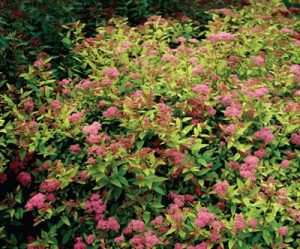Joshua Willis — March 1, 2012
A bread and butter staple for gardeners nationwide is put to the test at Longwood Gardens. Of the 26 cultivars on trial, nine emerge as clear winners.
What makes a plant sell? From the home gardener’s point of view, showy flowers will certainly do this. However, the horticulturist is looking for more: a diversity of leaf colors, forms and size to catch the eye in every season and fill many niches. For landscapers, ease of culture is important; they require fast establishment, tolerance of the urban environment, and pest resistance. Perhaps most importantly, nurserymen want a species to be inexpensively propagated and grown. In every phase of the life of a nursery-grown plant, economy of input and abundance of results make a plant (and those who use it) successful. The plant that can meet the conditions set by nurserymen, landscapers, horticulturists and weekend gardeners can sell in large numbers and at a profit.

Photos courtesy of Longwood Gardens unless otherwise noted.
Thus enters Spiraea japonica, which is reliably profitable for merchandisers and has much more than just flowers to catch the eye. Diversity of leaf color, form and size give this shrub an attractive appearance in every season, but, as usual, the long-lasting flowers are what help it move from the sales bench. A landscaper can appreciate it, too; it establishes fast (over the course of one season), and it tolerates more adversity than most ornamental plants. It will grow in all but the wettest of soil, tolerates lack of or excess nutrients, and keeps a good formal appearance throughout the seasons. The end product of all this urban tolerance and ease of establishment is a reliable ornament in the landscape.

‘Little Princess’ casts flower buds for a quick rebloom. Top of page, Spiraea japonica ‘Macrophylla’ exhibits typical spring redness.
Photo by Joshua Willis
Once planted, most cultivars will keep the desirable compact form, which rarely needs trimming to be maintained. This tidiness is complemented by seasonal foliage variation, with many cultivars bursting from the bud into vermillion or deep burgundy foliage before developing crisp yellows or rich greens. These qualities ensure that Spiraea japonica is widely used, but a new benefit has become apparent: deer avoid browsing it. Studies in diverse urban habitats have shown that it is rarely browsed, and is never browsed heavily. This asset is of value from the nursery fields to the customer’s home, and can add value in the customer’s eyes to place it above many other shrubs. Spiraea japonica is an excellent choice for suburban landscapes, especially where conditions are not perfect but the client’s expectations are high.
A plant for all seasons
Ideally, a plant provides four seasons of interest. Spiraea shines in three seasons and is architecturally significant in all four. Winter buds break into vivid shades of yellow and red, creating aesthetically pleasing foliage combinations on sepia-toned stems. This blush of spring gives way to a variety of crisp yellows and rich greens during the summer months, enduring until fall intercedes with a new palette of yellow and red interspersed with an occasional vibrant orange, which is quite attractive.

Spiraea japonica’Firelight’ exhibits red new growth, red-margined yellow leaves and bright red stems.
The majority of cultivars flower robustly in June and continue sporadically until the onset of frost. Stiff seed heads persist through the winter which, though faded to brown, do provide some continuing interest. These flower heads may be left undisturbed at the end of the season, being covered up by the next spring’s burgeoning shoots and subsequent flowers that will conceal them entirely. However, pruning spent inflorescences is recommended to initiate a second bloom later in the summer.

Goldflame’ spiraea fiery hues and glowing red stems.
Spiraea is easily cared for. This species will survive in most soils, from heavy clay to the smoothest of loams. It will take drought well and can thrive in damp situations, though will not do well in a saturated soil. One caveat is to not fertilize unless there is a nutrient deficiency. Light mulching on a yearly basis is more than sufficient.
A bit aggressive
Spiraea japonica has served American landscapes since the first cultivar was introduced from Japan in 1870. However, this stellar performer and people pleaser may soon be frowned upon due to a significant, although repairable, trait: invasiveness. Declared invasive in seven central-eastern states (Kentucky, Maryland, New Jersey, North Carolina, Pennsylvania, Tennessee and Virginia), it has a proclivity for spreading from gardens and into disturbed landscapes. It then infiltrates natural areas, where this species can be difficult to get rid of. Seedlings will appear even long after the original plants are removed unless regular deadheading had been practiced. Prevention is the best solution, though, and with this in mind scientists at Montana State University set out to discover sterile cultivars. Their success has been found in ‘Crispa’, ‘Dart’s Red’, and ‘Neon Flash’, which all failed to produce viable seed in an extensive study. Not only can these be touted as non-invasive, but they’re beautiful, durable cultivars. Though there are some 60 cultivars in cultivation today, it may still be profitable to breed new sterile ones.
Celebrating diversity
The species has proved to be a diverse group, and the recent lumping of Spiraea albiflora into Spiraea japonica shows this well. Spiraea ×bumalda, which used to designate the hybrid of these two species, is now obsolete and all Spiraea ×bumalda are now Spiraea japonica.
From the mountains of Japan, China, and Korea, S. japonica tolerates a climate with widely ranging temperature, moisture and light, thriving everywhere from forest floors to the sunny exposures of rocky crags. The native population varies much in physical characteristics and has great potential for widely divergent progeny to be produced from a single plant. As a result, many cultivars have been selected in cultivation. Popular cultivars have brightly colored flowers and interesting foliage, most with viable seeds and, unfortunately, significant invasive potential. Cultivars that retain desirable qualities but also feature sterility could be introduced and would make valuable replacements for those already popular.
The Longwood trials
Longwood Gardens conducted a trial from November 1999 to February 2007 attempting to determine the best performers for ornamental characteristics. Plants were grown in 12-foot-wide planting beds arranged in rows separated by 8 feet of turf. For each selection, three plants were acquired and grown. Most of the specimens were planted in the fall of 1999 and all plants were watered in for the first year to ensure their survival for the test. Throughout the trial, no maintenance was performed other than light spring pruning and pre-emergent herbicide application. None of the plants was irrigated after the first year, nor were they treated for pests or fertilized. Plants were placed in a 4-foot-square grid, with three of each taxon planted together for ease of judging and accuracy of comparison. Detailed phenological data was recorded, but the primary aim was to measure the impression each plant made. Our judges were from a variety of backgrounds and experiences; horticulture students, professionals in the trade, and Longwood staff and volunteers. While taking measurements of the individual plants and recording data, judges scored the plants according to how attractive they were, using a ranking system from one to five. Each plant was judged as 1 (unattractive), 2 (acceptable), 3 (attractive), 4 (very attractive) or 5 (best of class). A ranking of 5 meant that the individual plant was the most attractive of all those present.
Longwood Gardens has trialed 26 of the most popular cultivars of Spiraea japonica, striving to determine the best plants for the landscape. Most performed well in our trial, but nine clear winners were apparent. These splendid selections are described here in detail.

‘Anthony Waterer’ fills in underneath a tree, flowering profusely in part shade.
Photo by Joshua Willis
Spring
The plants in our trial separated into three main groups, depending on the season in which they performed best. Each winner received high marks and kept above-average scores for the rest of the year. For spring, ‘Firelight’, ‘Goldflame’, and ‘Neon Flash’ entertained with bright emerging foliage. Spiraea that did best in summer were particularly valued for their flowers and some for the cool yellow foliage. These were ‘Crispa’, ‘Genpei’, and ‘Lemon Princess’. Autumn was a particularly spectacular season, with myriad intense leaf colors emerging. ‘Anthony Waterer’, ‘Gumball’ and ‘Monhub’ were the showiest in this respect.
Coloration of emerging foliage was often quite striking. Most emerge with a deep red hue and mature to green relatively quickly, but every new leaf through the season will also emerge with various shades of crimson. Occasionally the small expanding leaves appear to be dainty little double flowers. New foliage coloration was noted often and admired much in our trials.
‘Firelight’, an improved selection from ‘Goldflame’, rated above 3.0 for April, May and June, as well as for September, October and December. Overall, it had a 2.6 average and received a score of very attractive five times. This is obviously a plant that can look very good. Judges mentioned that the yellow, orange and red colors of emerging leaves and even the fall color remind one of flames. An abundant midsummer display of pink flowers that faded to magenta and purple added much to the effect as well. Our specimens reached a maximum of 4 to 5 feet tall and were densely mounded during every season.

‘Lemon Princess’ is covered in pink blooms and retains yellow spring foliage well into summer.
‘Goldflame’, introduced in Holland in 1972, had a remarkable in-season record. Rating above 3.0 from April to October, it dazzled the judges with beautiful leaf color throughout the season. Emerging wine-red, the leaves turned yellow and pale green for the summer and changed to orange-gold and red in the fall. Overall, this cultivar scored a 2.7 and received its most consistent high ratings in April, due to emerging leaves. Flower color was bright pink and residual seed heads, which crowded the top of the plant, were approved of even until new growth appeared in spring.
‘Neon Flash’, a Japanese selection, received two 3.0 ratings, for May and June, and was also noted for emerging leaves. This cultivar sported deep green and maroon new leaves until June, when dark green came to dominate the color scheme until fall. Once again, burgundy, maroon and various shades of deep red were reported as major attractions, along with bright pink, sterile flowers. A 2.5 rating makes this Japanese selection a winner.
‘Nana’, ‘Candle Light’ and ‘Goldmound’ were also at their best in spring, but did not shine as brightly as the others. ‘Nana’, a wild-collected specimen from Japan, rated 2.5, though it was appreciated for its small size and annual covering of pink flowers. ‘Goldmound’, a Canadian selection from seed of ‘Goldflame’, came close to matching ‘Goldflame’ in most of its seasonal variation, but did not receive as high ratings. ‘Candle Light’, developed in England, received one score of 5 and was noted for a nice contrast of stem, foliage and flower color, but had a low average of 2.4.
Summer
Summer floral displays are far from rare, but Spiraea japonica is nevertheless valuable for its flowers when the majority of shrubs are finished blooming. The plants in our trials bloomed mainly in June and July, with occasional repeat blooms until fall. The winners described below had consistently high summer scores and looked attractive for most of the year.

‘Dart’s Red’ boasts a dense canopy of deep red flowers.
‘Genpei’, introduced from Japan in 1970, is a medium sized shrub at 4 feet by 6 feet, and it scored well throughout summer and into fall. Oddly, the leaves on this cultivar were green throughout the season, from budbreak to late summer. Fall color was yellow, but of nominal interest. The flowers, however, put on a fantastically varied display. Evaluators remarked on the unusual combination of white, pink and magenta and noticed the bees, which paid much attention to this selection. ‘Genpei’ flowered satisfactorily from June to August, with the major flowering event in mid June. Spent blossoms faded to white, giving the appearance of a longer floral display. An overall score of 2.7, with several monthly averages above 3.0, put this plant well above many others in our trial.
‘Lemon Princess’ is a yellow-leaved cultivar that has bright yellow new foliage and limey old foliage. In our trial it received six scores of 4 and one 5, with a year-round average of 2.8. It grows to a maximum of 4 feet by 4 feet, and judges noted that it could have nice form but was crowded. The plant was also notable in having an attractive color combination of chartreuse leaves with purple unopened flower bracts. ‘Norman’ was similar, but was not judged as many times in winter and had skewed results. It was also recorded as having an interesting color combination between purple bracts and green foliage.
Other cultivars that shined in summer were ‘Dart’s Red’, ‘Golden Elf’, ‘Little Princess’, and ‘Macrophylla’. Each of these performed well. ‘Golden Elf’ was praised as a potential groundcover from one evaluator, but was only rated four times and needed further evaluation. ‘Dart’s Red’, a bud sport of ‘Anthony Waterer’, and ‘Macrophylla’ met with mixed reception and were rated very attractive as often as they were rated unattractive. ‘Little Princess’, introduced from Holland, was said to have a dense covering of inflorescences when in flower, but never rated above a 3.
Fall
Already having knockout displays of emerging foliage and long-lasting flowers, a final season of interest and beauty is an unexpected bonus. In fall, variable and brilliant hues emerge before leaf drop. The show can be spectacular and long lasting. In our trials, several cultivars were especially noted for their fall show.
‘Anthony Waterer’, named for the plantsman at Knap Hill Nursery in England who discovered the selection as a bud sport in the late 1800s, has grown to prominence in nurseries and landscapes throughout the USA. In our trial it proved itself worthy for fall foliage, turning from dark green to yellow, and finally to red. An overall score of 2.7, with one score of 5 gave it a lead over similar cultivars ‘Coccinea’ and ‘Froebelii’, which both scored 2.6. The latter were of lower average score, but had attributes that the judges appreciated. ‘Froebelii’, for instance, was noted at being cleaner in appearance than ‘Anthony Waterer’. ‘Coccinea’, though it originated as a bud sport of ‘Anthony Waterer’, failed to stand out in any season quite as much.
‘Gumball’, a sport of ‘Froebelii’, came out of the study with a well-documented score of 2.7. Judges recorded that it topped out at 4 feet by 5 feet, always being neatly round with nice, slender stems. Leaves emerged chartreuse with a reddish tinge, became light green for the season, and in fall had various combinations of bronze, red, green and orange. Flowers were pink, appearing mainly in early June and sporadically thereafter.
‘Monhub’ grew to 4 feet by 4 feet and kept the typical mounded shape. A bud sport of ‘Goldflame’, the leaves were limey, though the color changed throughout the season, emerging lemony yellow, becoming light green for the season, and turning yellow and orange in autumn. Judges noted that even when not in bloom, ‘Monhub’ looked great, and when in bloom had an excellent coverage of delicate inflorescences. This cultivar received diverse ratings, with two scores of 5 and three scores of 1, being acceptable or attractive the rest of the time. Similar to ‘Limemound’, ‘Flaming Mound’ grew to the same size but received a 2.6 and was reported by one judge as having an unattractive flower and foliage combination.

Other selections that were at their best in fall but could not beat the cultivars described above were ‘Bullata’ and ‘Mertyann’. ‘Bullata’, a Japanese selection, was smaller than the others, reaching only 3 feet by 3 feet at the largest, but still had a good floral show and interesting foliage. Though it suffered tip dieback one year, it received favorable comments during the rest of the season. ‘Mertyann’, an open-pollinated seedling of ‘Little Princess’, grew to 4 feet by 4 feet and had a 2.4 average score, but failed to stand out in our trial group.
Longwood’s trial gleaned information allowing for better decisions to be made when selecting cultivars to grow. Spiraea japonica proves versatile, durable and beautiful; its value to modern landscapes is widely recognized. Though this species has been shown to be have invasive tendencies, recent research has discovered three sterile cultivars, ‘Crispa’, ‘Neon Flash’ and ‘Dart’s Red’. These may prove to be the beginning of a new wave of safer selections for the increasingly environmentally conscious landscaper. If the horticulture industry uses these cultivars and develops new cultivars with sterility in mind, Spiraea japonica can maintain its position in the American nurseryman and landscaper’s palette.
Joshua Willis is an undergraduate in the department of horticulture at Virginia Tech and was curatorial intern at Longwood Gardens in Kennett Square, Penn. He can be reached at [email protected]. Dr. Tomasz Aniśko is curator of plants at Longwood Gardens. He can be reached at [email protected].
References
Conover, M. R., and G. S. Kania, 1988. Browsing preference of white-tailed deer for different ornamental species. Wildlife Society Bulletin Vol. 16, No. 2, pp. 175-179.
Wilson, R.L. and W.A. Hoch. 2009. Identification of sterile, noninvasive cultivars of Japanese Spirea. HortScience 44(7): 2031-2034.